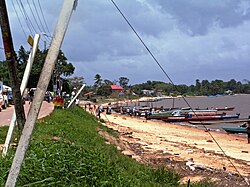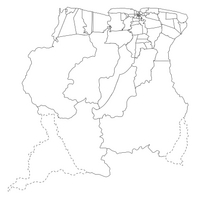Albina, Suriname: Difference between revisions
KittenKlub (talk | contribs) village section |
|||
| Line 128: | Line 128: | ||
Albina was founded on 13 December 1845 by [[August Kappler]], and was named after his wife. Kappler had left [[Germany]], and journeyed to Suriname. In February 1845 he noticed an abandoned [[indigenous people|indigenous]] village near the Maroni river. Later he met friendly indigenous and [[Maroon (people)|Maroon]] people nearby, and decided to settle in the village after having received permission.<ref>{{Cite web|title=Encyclopaedie van Nederlandsch West-Indië - Page 398 - Kappler (August)|website=[[Digital Library for Dutch Literature]]|url=https://www.dbnl.org/tekst/benj004ency01_01/benj004ency01_01.pdf|date=1916|access-date=19 May 2020|language=nl}}</ref> By 1913, there was a little town with a medical clinic, and Albina was home to 349 men and 266 women.<ref>{{Cite web|title=Encyclopaedie van Nederlandsch West-Indië - Page 36 - Albina|website=[[Digital Library for Dutch Literature]]|url=https://www.dbnl.org/tekst/benj004ency01_01/benj004ency01_01.pdf|date=1916|access-date=19 May 2020|language=nl}}</ref> |
Albina was founded on 13 December 1845 by [[August Kappler]], and was named after his wife. Kappler had left [[Germany]], and journeyed to Suriname. In February 1845 he noticed an abandoned [[indigenous people|indigenous]] village near the Maroni river. Later he met friendly indigenous and [[Maroon (people)|Maroon]] people nearby, and decided to settle in the village after having received permission.<ref>{{Cite web|title=Encyclopaedie van Nederlandsch West-Indië - Page 398 - Kappler (August)|website=[[Digital Library for Dutch Literature]]|url=https://www.dbnl.org/tekst/benj004ency01_01/benj004ency01_01.pdf|date=1916|access-date=19 May 2020|language=nl}}</ref> By 1913, there was a little town with a medical clinic, and Albina was home to 349 men and 266 women.<ref>{{Cite web|title=Encyclopaedie van Nederlandsch West-Indië - Page 36 - Albina|website=[[Digital Library for Dutch Literature]]|url=https://www.dbnl.org/tekst/benj004ency01_01/benj004ency01_01.pdf|date=1916|access-date=19 May 2020|language=nl}}</ref> |
||
On 22 July 1986, the [[Surinamese Interior War]] started. That night, the [[Jungle Commando]] |
On 22 July 1986, the [[Surinamese Interior War]] started. That night, the [[Jungle Commando]], led by [[Ronnie Brunswijk]], opened fire on the [[army barracks]] in Albina. The fighting lasted three hours. One soldier and two civilians were wounded.<ref>{{cite news|url=https://www.digibron.nl/viewer/collectie/Digibron/id/02408c77d71f20c8befc27ebdb7cf197|title=Leger Suriname zoekt gijzelaars |website=Reformatorisch Dagblad via [[Delpher]]|date=26 July 1986|access-date=19 May 2020}}</ref> The [[Military of Suriname|National Army]] responded by destroying the temple in [[Moengotapoe]], and capturing all males present.<ref>{{cite web|url=http://rozenbergquarterly.com/the-kingdom-of-the-netherlands-in-the-caribbean-suriname-1954-2004-kroniek-van-een-illusie/ |title=The Kingdom Of The Netherlands In The Caribbean. Suriname 1954 – 2004: Kroniek van een illusie|website=Rozenberg Quarterly|access-date=14 May 2020|language=nl}}</ref> During the civil war which followed, great parts of the area, including much of the town of Albina, and the road, were destroyed. It also caused a refugee crisis into [[French Guiana]].<ref>{{cite web|url=https://www.suriname.nu/175alg/marowijne02.html|title=Distrikt Marowijne|access-date=19 May 2020|language=nl|website=Suriname.nu}}</ref> |
||
{{main|2009 Albina, Suriname riots}} |
{{main|2009 Albina, Suriname riots}} |
||
Revision as of 23:15, 18 March 2021
Albina | |
|---|---|
 Albina in 2008 | |
 Map showing the resorts of Marowijne District. Albina | |
| Coordinates: 5°30′N 54°03′W / 5.500°N 54.050°W | |
| Land | |
| District | Marowijne District |
| Resort (municipality) | Albina |
| Area | |
| • Total | 397 km2 (153 sq mi) |
| Elevation | 5 m (16 ft) |
| Population (2012 census)[1] | |
| • Total | 5,247 |
| • Density | 13/km2 (34/sq mi) |
Albina is a town in eastern Suriname, and is capital of the Marowijne District. The town lies on the west bank of the Marowijne river (Maroni river), which forms the border with French Guiana, directly opposite the French Guianan town of Saint-Laurent-du-Maroni, to which it is connected by a frequent ferry service. Albina can be reached by bus via the East-West Link. The distance between Paramaribo and Albina is about 150 kilometres (95 mi). [2]
History
Albina was founded on 13 December 1845 by August Kappler, and was named after his wife. Kappler had left Germany, and journeyed to Suriname. In February 1845 he noticed an abandoned indigenous village near the Maroni river. Later he met friendly indigenous and Maroon people nearby, and decided to settle in the village after having received permission.[3] By 1913, there was a little town with a medical clinic, and Albina was home to 349 men and 266 women.[4]
On 22 July 1986, the Surinamese Interior War started. That night, the Jungle Commando, led by Ronnie Brunswijk, opened fire on the army barracks in Albina. The fighting lasted three hours. One soldier and two civilians were wounded.[5] The National Army responded by destroying the temple in Moengotapoe, and capturing all males present.[6] During the civil war which followed, great parts of the area, including much of the town of Albina, and the road, were destroyed. It also caused a refugee crisis into French Guiana.[7]
On 24-25 December 2009, the Albina riots took place,[8] when local Maroon inhabitants attacked Brazilian, Chinese, Colombian and Peruvian gold prospectors after a man was allegedly stabbed to death by a Brazilian.[9] The riots caused one death,[8] and at least 24 wounded.[10]
Transport
Plans have been made to build a bridge between Suriname and French Guiana, however as of May 2020, no action has been taken.[11][12]
The town has a small airport, the Albina Airstrip, with a 650-metre (2,150 ft) asphalt runway in use since 1953.
Albina has a small boat (korjaal) connection to Galibi. The journey across the water takes about 1.5 hrs. There is a beach and a small tourist shop. The main reason tourists visit Galibi is to see the turtles, which come from all over the world (including places as distant as Costa Rica and Australia) to lay their eggs in Suriname.[13]
Notable people
- Henk Chin A Sen (1934-1999), former President of Suriname.[14]
- Olton van Genderen (1921-1990), politician.[15]
- Oscar Harris (1934), musician.[16]
Villages
- Alfonsdorp is an indigenous Lokono village.[17]
- Bigiston is a group of Ndyuka Maroons and indigenous Kalina villages.[18]
Sister cities
5°30′N 54°03′W / 5.500°N 54.050°W
References
- ^ "Resorts in Suriname Census 2012" (PDF). Retrieved 19 May 2020.
- ^ "Transport". Ministry of Transport, Communication and Tourism (in Dutch). Retrieved 19 May 2020.
- ^ "Encyclopaedie van Nederlandsch West-Indië - Page 398 - Kappler (August)" (PDF). Digital Library for Dutch Literature (in Dutch). 1916. Retrieved 19 May 2020.
- ^ "Encyclopaedie van Nederlandsch West-Indië - Page 36 - Albina" (PDF). Digital Library for Dutch Literature (in Dutch). 1916. Retrieved 19 May 2020.
- ^ "Leger Suriname zoekt gijzelaars". Reformatorisch Dagblad via Delpher. 26 July 1986. Retrieved 19 May 2020.
- ^ "The Kingdom Of The Netherlands In The Caribbean. Suriname 1954 – 2004: Kroniek van een illusie". Rozenberg Quarterly (in Dutch). Retrieved 14 May 2020.
- ^ "Distrikt Marowijne". Suriname.nu (in Dutch). Retrieved 19 May 2020.
- ^ a b Elizondo, Gabriel (December 27, 2009). "Christmas violence in Suriname". Al Jazeera. Archived from the original on December 31, 2009. Retrieved December 27, 2009.
- ^ "Conflito no Suriname levou a pelo menos 7 mortes, diz missionário" (in Portuguese). G1 Globo.com. December 26, 2009. Archived from the original on December 31, 2009. Retrieved December 27, 2009.
- ^ "Missão da FAB deve ir ao Suriname para prestar auxílio a brasileiros" (in Portuguese). G1 Globo.com. December 26, 2009. Archived from the original on December 30, 2009. Retrieved December 27, 2009.
- ^ IIRSA.org - Improvement of the Marowijne River International Crossing Archived 2011-07-25 at the Wayback Machine - project summary
- ^ Indianfeelings.nl - Fusie Suriname en Franks Guyana?
- ^ "Galibi Tour naar Galibi Zeeschildpadden". Galibi Suriname (in Dutch and English). Retrieved 19 May 2020.
- ^ "Wat gebeurde er in Januari in Suriname". Suriname.nu (in Dutch). Retrieved 19 May 2020.
- ^ "Olton van Genderen Stichting" (in Dutch). Retrieved 19 May 2020.
- ^ "Oscar Harris". Suriname.nu (in Dutch). Retrieved 19 May 2020.
- ^ "Dorpen en Dorpsbesturen". Vereniging van Inheemse Dorpshoofden (in Dutch). Retrieved 22 February 2021.
- ^ "Winti Practives in Bigiston. Page 21". Research Gate. Retrieved 31 May 2020.
External link
 Media related to Albina, Suriname at Wikimedia Commons
Media related to Albina, Suriname at Wikimedia Commons

